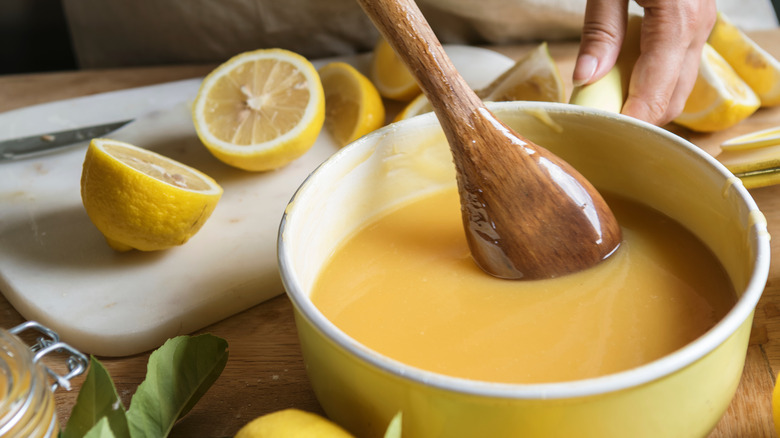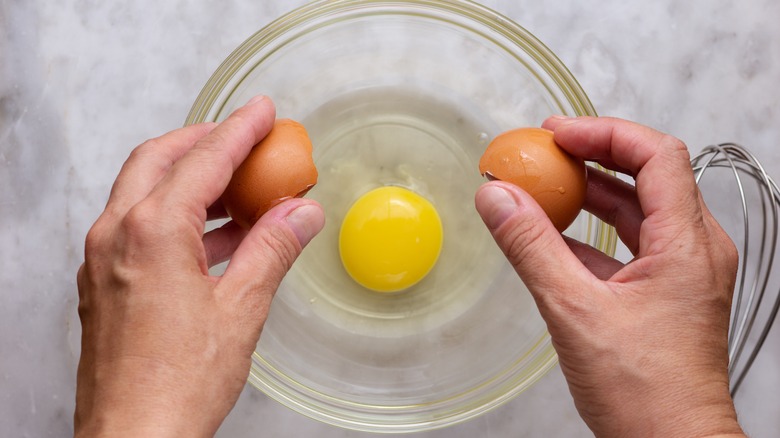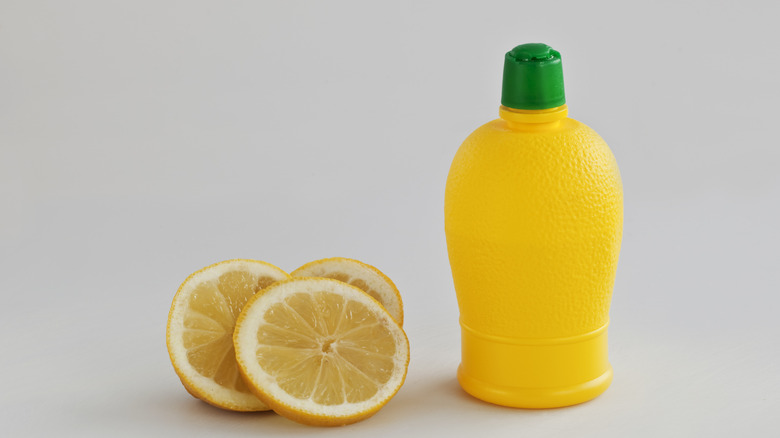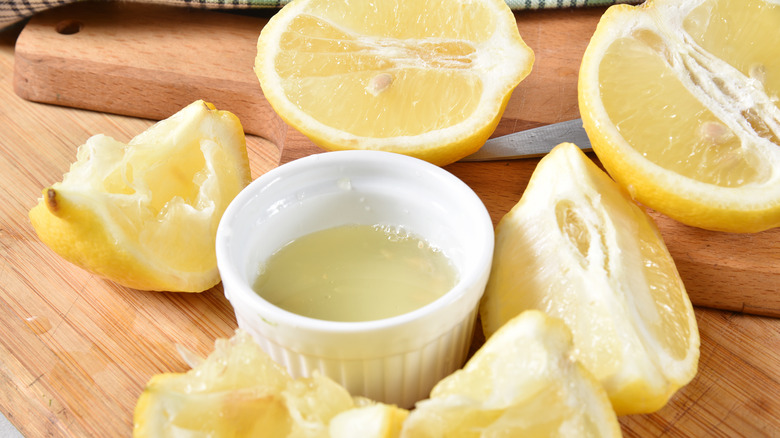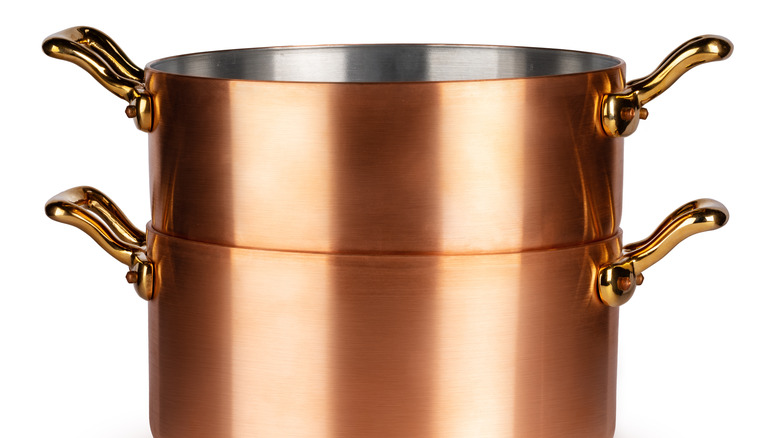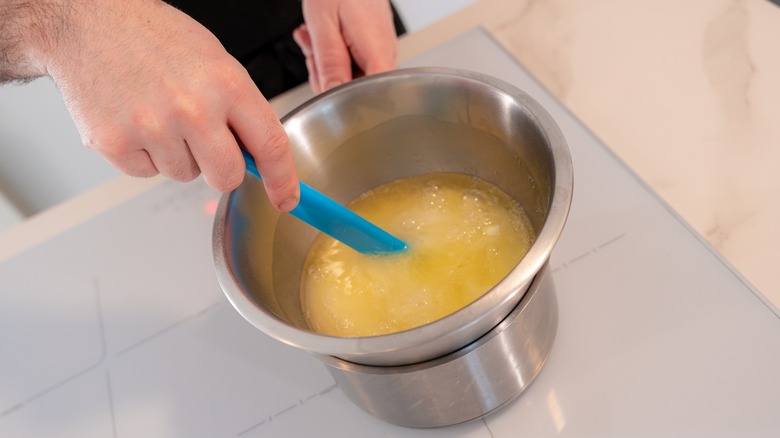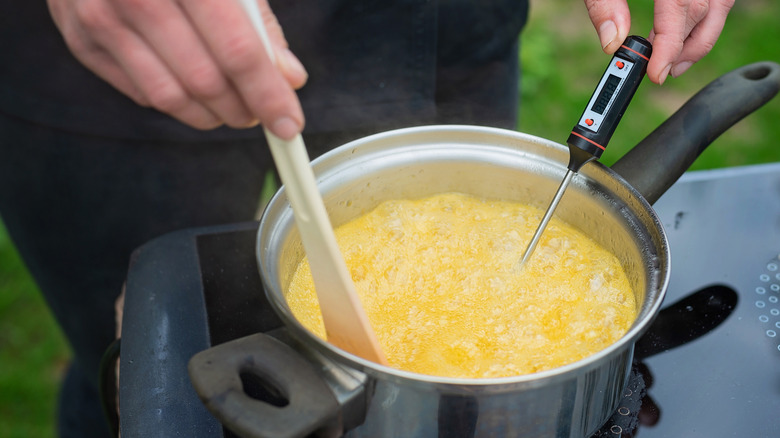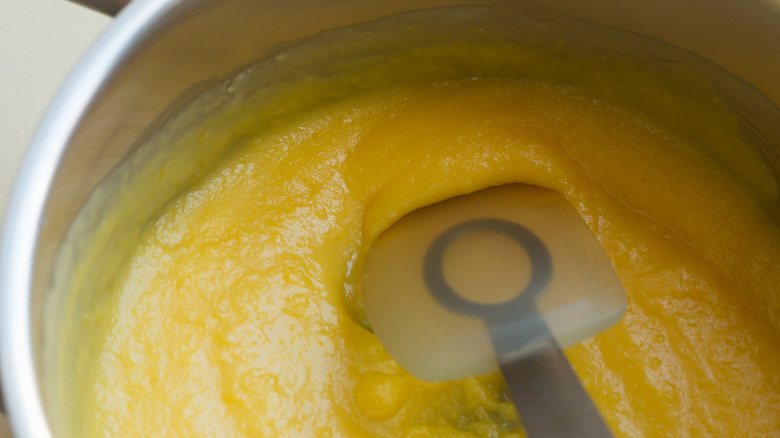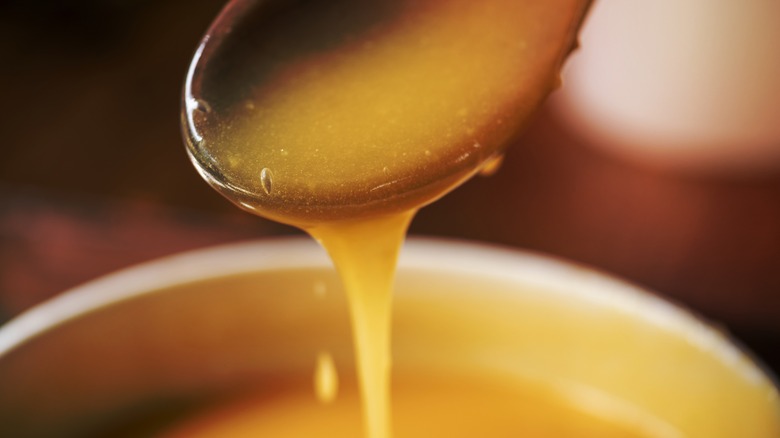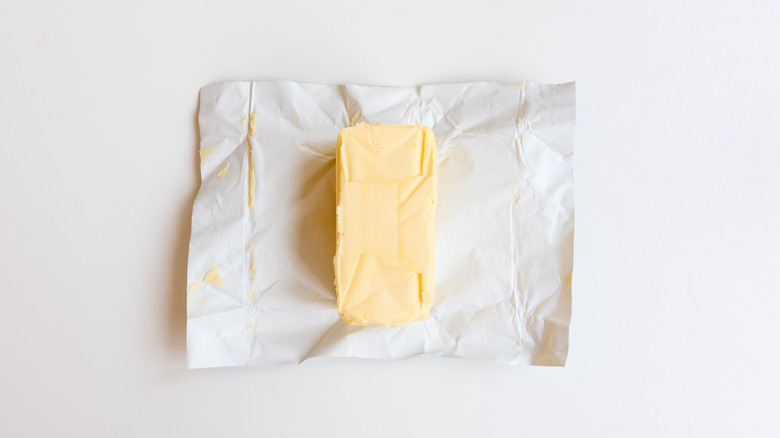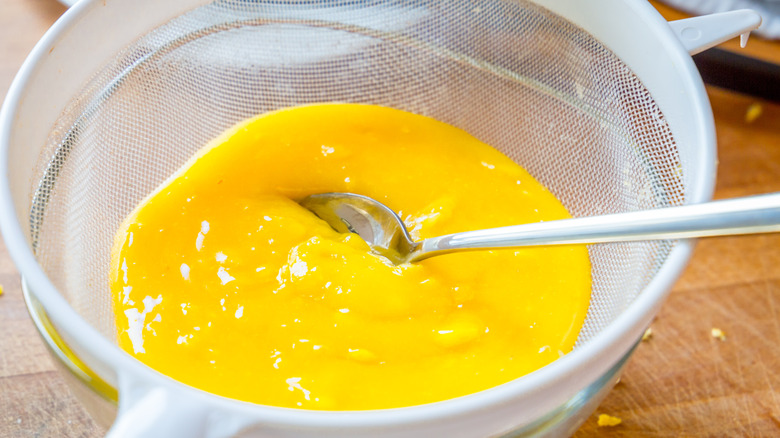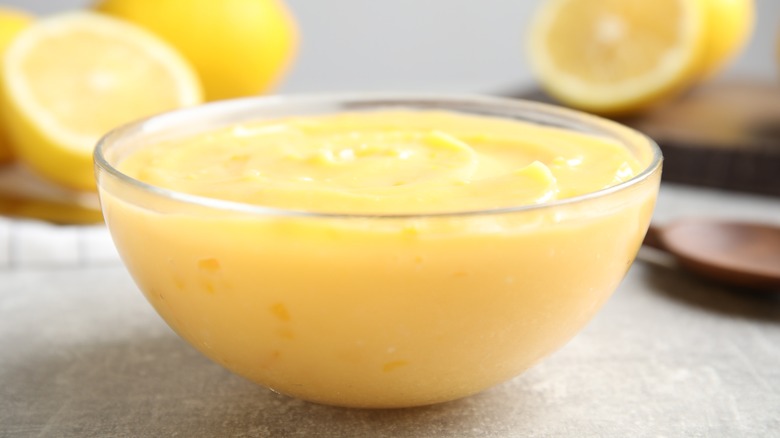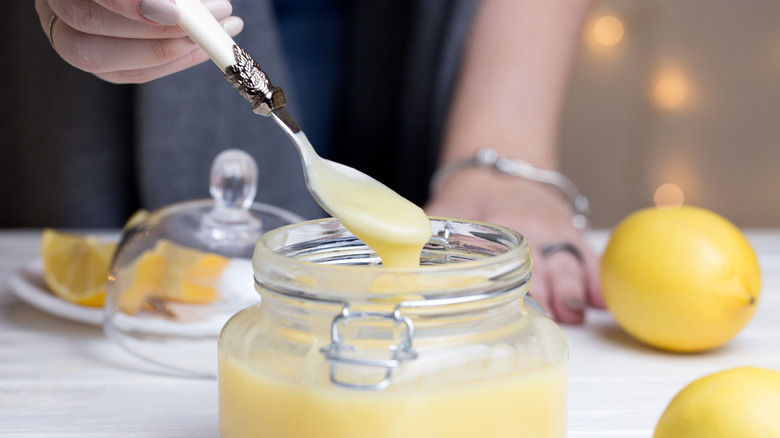12 Mistakes To Avoid When Making Lemon Curd
If your lemon curd constantly turns out like scrambled eggs — instead of a velvety and soft spread — you might have some homework to do. If you can never get it quite thick enough — and it's more of a lemon sauce — the same goes. Ideally, you should be able to lift a dollop of your lemon curd with a spoon and smear it on a pastry without it all dripping off. But don't fret if you have trouble getting it down. Once you know the right formula and cooking methods, all of the lousy lemon curd will be in the past.
Lemon curd is made from whole eggs, egg yolks, butter, sugar, lemon zest, and juice. However, some recipes only require egg yolks. This recipe is often described as something between a custard and pudding. Its consistency is closer to pudding, except it isn't usually made with cornstarch. Instead, the eggs help the mixture become firmer and transform into the perfect texture. You can use it in savory dishes, such as with pan-fried chicken and thyme, or as a filling in a gorgeous layered cake.
1. Not using enough yolks
Not using enough yolks in your lemon curd can negatively impact the quality of the final product. First, although the lemon juice provides hints of yellow, the deep golden color comes from the yolks. So, when you use a recipe that only uses whole eggs, your lemon curd will appear much lighter, because of the large amount of whites. Additionally, using too many whites can cause your lemon curd to taste egg and sulfurous, which many people find unappetizing.
The sulfur in the whites can also lead to an unpleasant smell, which you certainly don't want. The smell is worse in older eggs, so try to use fresh ones if possible. The smell is also more noticeable when you overheat the eggs.
Above all, when you include too many whole eggs and an insufficient amount of yolks, the curd doesn't have that much-appreciated silky texture. This is because the yolks make the mixture creamy and rich, due to their high fat content. Try to use a recipe that calls for whole eggs, as well as added yolks, to have the ideal balance. Or, you can try a recipe that uses yolks exclusively.
2. Opting for store-bought lemon juice
While it is convenient for you to purchase lemon juice concentrate from the store, it isn't the best move when you want to make incredible lemon curd. Even if the bottle states that it's 100% lemon juice, it might still have added ingredients, such as preservatives. The store-bought product goes through a pasteurization process which extends its shelf-life but slightly alters its composition in the process. According to a National Library of Medicine study, its color isn't as vibrant when it's pasteurized. The nutrient content and flavor can also change.
Therefore, using fresh lemon juice will give you an all-around better product. Often, recipes call for lemon zest, which imparts a deep citrus flavor, so if you already have to purchase lemons for their peel, you might as well take advantage of their juice. Ultimately, since lemon curd only contains a handful of ingredients, it's crucial to be picky about them, especially with the most important ingredient.
3. Preparing the lemons incorrectly
First, don't make the mistake of juicing the lemons before zesting them. Although it's possible to extract juice from the fruit you already cut, it's much harder. Additionally, it's smart to use a Microplane or a similar tool. These kitchen devices will create very thin, small shreds compared to a cheese grater.
If you use a cheese grater, you might accidentally remove the pith – the white layer before the lemon's interior. The pith is known to have an unpleasant taste that can affect the overall flavor of the lemon curd. Once juiced, don't forget to strain the lemon juice to ensure no seeds are in the mixture.
Lastly, another mistake you need to stop making with lemons is to make the best use of the juice inside them. To make the most of them, place the lemons in the microwave for about 10 seconds. This makes them easier to juice because the heat makes them softer. Additionally, use a fork or a whisk to break the membrane after you cut the lemon. This also helps to produce more liquid, whether you juice them by hand or use a gadget.
4. Using reactive cookware
You might think nothing of it when you use copper or aluminum cooking equipment, but it has the ability to destroy your lemon curd. A chemical reaction that occurs between the lemon juice and these materials can turn your curd green. Since lemon juice has so much acid, some particles from the metal transfer from the reactive equipment to the food. So, yes, as you can imagine, it also changes the taste, which causes an unpleasant, metallic undertone.
This instance can even happen in non-stainless steel or iron cookware, so it's important to know what material your equipment is before you make lemon curd with it. Some companies put a coating on cookware, which makes these types of cookware non-reactive, but it's best to double-check and ensure that your specific pots and pans are safe for working with acids. However, heat-safe glass and stainless steel are fantastic options when you don't want to take risks.
5. Failing to use a bain-marie
Many recipes suggest making lemon curd on the stovetop. Although it's possible to successfully make it this way, it puts you at a higher risk of burning the mixture or cooking it unevenly.
Cooking on the stovetop differs from using an oven, where you can set the exact temperature. If a recipe says to put the control knob on medium-low heat, that will be different for every range. If you make something delicate with many eggs — such as lemon curd — it's much safer if you use indirect heat.
For indirect heat, you can use a bain-marie, also known as a double boiler. You can purchase a double boiler setup where two pots stack and fit directly on each other. To use, add a small amount of water to the bottom pot and simmer it. This allows the steam to rise while heating the contents in the top portion. However, you can also create a bain-marie with a pot and a heat-safe bowl that rests on top.
Whatever you do, be sure to not make the common double boiler mistake of filling the bottom pot too high, which can result in the water touching the upper cookware. This defeats the whole purpose of using the indirect heat from a double-boiler since this creates direct heat. Also, it's dangerous since it can boil over and burn you. Start with two to three inches of water, then occasionally check it to see if it needs more.
6. Letting it get too hot
Even if you use a double boiler to make the lemon curd, it's still possible to overcook the mixture. One important thing to remember when you make this delicious spread is that it should never boil when you cook it. Lemon curd only needs to reach around 170 degrees Fahrenheit to properly set and thicken. Unfortunately, it can turn chunky or grainy if you allow it to get above the recommended temperature. Additionally, if your mixture begins to approach 180 degrees Fahrenheit, the mixture will start to give off an odor.
Moreover, whether your curd has whole eggs or just yolks, they can coagulate, creating chunky egg pieces throughout the mixture. You might be tempted to try and rescue the mixture by straining out the egg pieces, but then you are missing a major piece of the puzzle — since the eggs act as the primary thickener for the recipe.
If you have a kitchen thermometer, go ahead and utilize it when you make lemon curd. It's an accurate way to differentiate between a mixture you need to cook longer and a mixture on the verge of boiling.
7. Neglecting to stir it enough
Lemon curd will unevenly cook if you don't mix it enough. Even if you take the right steps — by assembling a bain-marie and constantly watching it — you can't let it cook without any agitation whatsoever. This is because the mixture contains so many eggs, so the bottom part of the curd that touches the bowl cooks faster than the rest.
This can lead to a gluey layer on the bottom that's hard to blend into the softer part of the curd — it's similar to when you make something like cake batter or buttercream. These recipes also turn lumpy if you don't continuously scrape the sides of the bowl. However, lemon curd is even more fragile because it cooks into a rubbery or crusty rim on the sides. To avoid this, use a rubber spatula that has some flexibility — so it can get the curd in hard-to-reach places in the pot or bowl — and constantly stir the mixture to ensure the heat distributes evenly throughout.
8. Undercooking it
If you don't cook the mixture long enough or let it get hot enough, it can be just as disastrous as overcooking it. Sadly, undercooked lemon curd stays soupy even after it fully cools. This means you won't be able to use it for its intended recipes, like cake topping.
Undercooked lemon curd is also a cause for concern if you don't use a cooking thermometer. If the eggs don't reach at least 160 degrees Fahrenheit, the United States Department of Agriculture states it isn't safe to eat. However, if you determine that your lemon curd has reached a safe temperature and still seems loose, it's possible it just needs longer on the stovetop.
Observe your lemon curd to ensure it stays in the suggested temperature window, while you give it more time to cook. As a rule of thumb, the curd must be nappe-consistency before you remove it from the heat. "Nappe" is a French cooking term referring to when a sauce or spread can coat the back of a spoon without dripping off, and it's your indication that the mixture will cool to the correct thickness. If you dip a spoon in the mixture and then run your finger on the spoon, the lines of the lemon curd should stay in place.
9. Adding butter in the wrong way
Some recipes ask you to add the butter after the lemon curd cooks. With this method, you must correctly introduce the butter, because you are forming an emulsion between the butterfat and the water from the lemons.
The truth is that if you throw all of the butter in at once, you might ruin the curd. The mixture won't properly emulsify. This means it might look separated and oily, which makes it difficult for the butter chunks to fully melt. You shouldn't use room-temperature butter either. This practice will prevent the fat from blending into the lemon mixture smoothly.
Instead, chop the butter into tiny cubes and place them in the refrigerator. When you want to add it to the mixture, add it to the cooked curd a few pieces at a time, waiting for the cubes to melt until you add more. As a result, the butter functions as a second thickener, aside from the eggs, and simultaneously cools the curd, which helps stop the cooking process.
10. Forgetting to strain it
For the silkiest, smoothest lemon curd possible, don't make the mistake of serving it lumpy. You should definitely strain it, but not with a regular old strainer. Instead, use a mesh strainer or other fine sieve that only allows liquids or sauces to pass. It might take some work to press the lemon curd against the strainer with a spoon. Although it seems like a hassle, or maybe just overkill, it helps remove any impurities in the lemon curd.
These impurities could be eggy bits or lemon seeds. You'll also want to strain out the white string that you often find in raw egg yolks if it wasn't removed when you measured the eggs. Additionally, this process removes the zest. Usually, the oil from the zest helps give the curd that bright, citrusy flavor while it cooks. However, it's not needed in the final product because it gives it a gritty feel.
11. Wrapping and storing it incorrectly
A major slip-up you want to avoid is improperly wrapping the lemon curd. With most foods, you can loosely wrap them, but with this mixture, the plastic wrap needs to touch it directly — otherwise, a film forms on the top of the curd that you have to skim off. If you try to mix it in, it might make the curd lumpy and ruin all your hard work. Nevertheless, the film is still edible. It just doesn't have the most appealing look, so you can remove it and use it for something else.
Additionally, don't transfer hot lemon curd directly to the refrigerator. It's wise to place it in a shallow container — this will make it cool quicker — and allow it to sit out for a while. You can even go the extra mile and put this container over an ice bath, accelerating the process and preventing overcooking and separation. Then, move it to the refrigerator once it's at room temperature. Later, you can place it in a jar or container when it is thicker. It doesn't need plastic wrap pressed on it forever, only while it cools. But it will always need an airtight lid to keep it fresh.
12. Not waiting long enough for it to set
If you try to serve the lemon curd prematurely, it doesn't reach its full potential and the mixture is too runny. Part of the magic of lemon curd is how its mouthfeel is silky and creamy yet substantial enough to provide richness. Sadly, this doesn't happen in the blink of an eye; it needs a few hours to set. Therefore, it's not a good idea to rush and make it the same day you need it.
However, since homemade lemon curd lasts two weeks, you can make it in advance and have it ready to go for any occasion. You can even make it days ahead of time — as long as you keep it tucked away in your refrigerator and sealed. This way, you don't need to worry about a backup plan; it'll be perfectly thick and ready to slather on warm blueberry scones, fresh fruit tarts, or whatever your heart desires.
